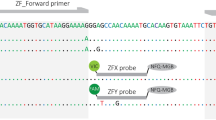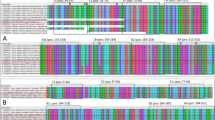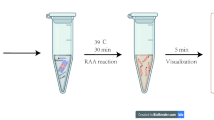Abstract
Existing molecular techniques to determine sex of pinnipeds rely on multiplex PCR amplification and gel electrophoresis, and are consequently expensive, time consuming, insensitive and involve handling hazardous DNA-binding dyes. We developed a qPCR high resolution melt assay that involves a single multiplex PCR with dissociation/melting-curve analysis to determine the melting point temperatures (Tm) of two PCR products. Two sets of primers were selected to amplify short regions of the SRY and ZFX/ZFY loci for molecular sex identification. Primers were designed based on alignment of a broad range of pinniped species to maximize applicability for most or all of the 33 species representing two complete superfamilies in the sub-order Caniformia. The assay was validated using 15 pinniped species totaling 122 animals of known sex. The co-amplification of short products also demonstrated improved results for sex determination of degraded samples. The use of a single step qPCR saves time and reduces the cost of running sex determination tests through reduction of labor and supply costs. This new technique will generate results more quickly and reliably, aiding in the study of population health and sex-specific dispersal and behavior patterns.
Similar content being viewed by others
Avoid common mistakes on your manuscript.
Introduction
Sex determination is critical to the study of population health, sex-specific dispersal, life history, and behavior patterns in pinnipeds. However, pinniped sex determination can be difficult. Several pinniped species do not demonstrate clear sexual dimorphism, making visual field identification of sex nearly impossible (Shaw et al. 2003). Physical exam is not always straight-forward as male phocid pinnipeds have internal genitalia with the penile opening located behind the umbilical scar (Curtis et al. 2007).
Gel-based molecular sexing methods can be expensive, time-consuming, insensitive, and involve hazardous dyes. Previous pinniped sexing assays have employed large PCR fragments which may not amplify from degraded DNA and take hours to electrophorese on an agarose gel (Shaw et al. 2003; Curtis et al. 2007; Sanvito et al. 2014). Others have used only one amplicon (SRY; Reed et al. 1997) to amplify males only, however, interpretation is difficult as absence of a PCR product band on the gel does not necessarily mean the sample is from a female, as it could result from a failed amplification of a male sample. Matejusova et al. (2013) employed two TaqMan (5′ exonuclease fluorescence) qPCR assays for ZFX/ZFY and SRY genes for gray and harbor seals; the secondary assay is a male specific assay (SRY only) to control for misinterpretation of a failed male and female sample amplification.
Chang et al. (2008) developed a high-throughput qPCR method using a high resolution melt (HRM) assay with melting-curve analysis (MCA) to amplify and distinguish the Tm (melting temperatures) of two sex specific products for birds. Although not widely tested, it proved successful for two bird species. The real-time HRM method measures and plots changes in double-stranded DNA-specific fluorescence with temperature as PCR products of different sizes become denatured at different temperatures. The resulting HRM plots show a single melt-curve peak for females, and two peaks for males. Following from this, we adapted the protocol for pinnipeds by designing primers based on alignment of a broad range of pinnipeds species. The assay was validated using 15 pinniped species totaling 122 animals of known sex. The use of real-time fluorescence methods allows for higher safety, sensitivity, efficiency and lower cost.
Methods
Samples and species were selected based on their availability in the SWFSC’s MMASTR Collection (National Marine Mammal and Sea Turtle Research Collection) and the criteria of being positively identified as male or female based on field ID from tagging events or collection of reproductive organs from dissections (Table 1). Tissues (skin or muscle of varying quality) were preserved frozen at −20°, in a 20% salt-saturated DMSO solution or in 100% ETOH. Genomic DNA was extracted using sodium chloride precipitation (Miller et al. 1988) or a silica-membrane method (Qiaxtractor® DX reagents, Qiagen, Valencia, CA, USA).
A single multiplex qPCR assay was developed to take advantage of the melting curve or dissociation curve analysis immediately following PCR. Two primer sets were used, SRY53-3c/ SRY53-3d (Fain and Lemay 1995) and PinZFXY_F/PinZFXY_R (SWFSC; Table 2). PinZFXY_F/PinZFXY_R primers were designed by aligning previously published ZFX/ZFY sequences from six seal species, one sea lion and one bear (Table 3). Amplicon sizes are 224 and 168 bp for SRY and ZFXY, respectively, allowing for good separation to easily distinguish the melting temperature peaks in the dissociation curve analysis. The qPCR was performed on a Stratagene MX3000p (La Jolla, CA, USA) using EvaGreen™ fluorescence dye (PN31000, Biotium, Hayward, CA) in a 25 µl reaction with a final concentration of 1× Bioline NH4 buffer (Bioline USA Inc., Taunton, MA, USA), 6.0 mM MgCl2, 250 µM each dNTP, 0.2× EvaGreen, 1× ROX reference dye (Invitrogen, PN54881), 600 nM each primer, 0.05 U/µl of HotStar Taq polymerase (Qiagen), and 10–20 ng of DNA. qPCR cycling conditions were: initial incubation for 15 min at 95 °C, followed by 40 cycles of 95 °C for 30 s, 60 °C annealing temperature for 30 s and 72 °C for 30 s. The Dissociation curve program for HRM is one cycle of 95 °C for 1 min, 55 °C for 30 s and a ramp of 0.01 °C/sec to 95 °C (to slow melt the product) added to the end of the regular qPCR.
To test for accuracy, each amplification batch included the same male and female positive controls as well as 10% replication of the unknown sex samples. At least two PCR negative controls were included in each batch to control for contamination. If a sample failed to amplify, three more attempts were made at differing DNA dilutions. In addition, all samples were processed using the gel based protocol of Fain and LeMay (1995) to check for allelic dropout or sexing identification errors. The Fain and LeMay (1995) assay amplifies two products, a 442 bp amplicon from the zinc finger gene (ZFX and ZFY) and a 224 bp amplicon from the SRY gene. Visualization on the gel of two PCR bands indicates a male and a single band at 442 bp is a female.
To further validate the assay, a 450 bp region of the SRY locus was sequenced to check for polymorphisms that could cause false positives in some females (see below). Sequencing primers were designed by aligning 13 seal SRY sequences from GenBank that encompassed the Fain and Lemay (1995) SRY product (Table 3).
Standard PCR and sequencing methods were used. A 516 bp region of the SRY locus was amplified using primers SRY476_seal_F1 and SRY991_seal_R1 (Table 2). DNA was amplified using a 25 µl reaction of 1 µl DNA (5–20 ng), 1× ThermoPol Reaction Buffer [20 mM Tris–HCl, 10 mM (NH4)2SO4, 10 mM KCl, 2 mM MgSO4, 0.1% Triton®-X-100, pH 8.8; NEB, Ipswich, MA, USA], 150 µM each dNTP, 300 nM of each primer, and 0.05 U/µl Taq DNA polymerase. The PCR cycling profile consisted of 94 °C for 2.5 min, followed by 35 cycles of 94 °C for 45 s, an annealing temperature of 60 °C for 1 min, and 72 °C for 1.5 min, then a final extension of 72 °C for 5 min. Sequencing of the PCR product in both directions was performed with the same primers on an ABI 3130XL Automated Sequencer (Applied Biosystems Inc., Foster City, CA). All sequences were aligned using Sequencher v4.8 software (Gene Codes Co, Ann Arbor, MI), resulting in 450 bp sequences after trimming primers and poor quality regions.
Initial sequencing was performed on 9 samples from 4 species (3 male and 2 female bearded seals, 2 male ringed seal, 1 male harp seal and 1 male gray seal). An additional 15 female bearded seals were used to try to amplify SRY product, with 2 of the 7 males used as positive controls.
Results
The melting point temperatures (Tm) of the two amplicons demonstrated clear separation with two peaks in the melt curve for a male (Tm 84°, 88°) and one peak for a female (Tm 84°). Figure 1 shows examples of the Dissociation Curve graphs with the Tm peaks for (a) a male, (b) a female and (c) a single run of 7 samples and 1 PCR negative control. Variation in peak height is observed due to variation in sample quality and amount of template DNA.
We were able to confirm morphologically identified sex of 109 of 122 samples representing 14 of 15 species tested. Five (4%) of the 122 samples failed to amplify: 2 bearded seals, 1 ringed seal, 1 leopard seal and the single Guadalupe fur seal. These failures are likely due to DNA quality issues and not a species-specific issue, as the same samples also failed the gel based assay. Overall, the qPCR assay was observed to be more robust than the gel based assay as 21 (17.2%) of the samples failed the gel based assay including the same 5 samples as above.
Discrepancies in the genetic sexing results vs the field observation data were found in 8 (7.3%) of the 109 samples, involving 6 different species and both types of errors (male to female, female to male). The qPCR assay and the gel based assay results agreed for all 8 samples, indicating either data entry issues, tissue sample mix up, or mis-identification of sex in the field. No correlation was found in the 8 samples to indicate single species differences or more errors within a particular sex. We were able to confirm that one discrepancy was a data entry error in our database. For the remaining seven samples, no reproductive organs were observed. Only visual external exams were completed to determine sex, leading to the possibility of a mis-identification of sex in the field, or the presence of previously undocumented sex-reversal in pinnipeds.
SRY sequencing was conducted because we observed some morphologically identified female samples to have a small peak in the SRY position in the melt curve. The peak was consistently much smaller than observed in confirmed males, but we were concerned that it could be due to polymorphism in the SRY sequences that resulted in poor amplification in some mis-identified males that could lead to incorrect sexing. No polymorphisms or variants were found in seven male sequences (3 bearded seals, 2 ringed seals, 1 harp seal, 1 Gy seal) when compared to the published sequences for these species (Table 3), and two female samples that exhibited small SRY melt-curve peaks did not amplify the larger SRY product. The additional 15 morphologically identified females that were tested (8 showing the small SRY peak and 7 not showing the small SRY peak) also did not amplify. The two male controls amplified as expected.
Discussion
With the development of this assay, we are able to reduce costs and obtain sexing results more quickly and with greater sensitivity than with a gel-based assay. We estimate the qPCR based assay is roughly 60% of the cost of the gel based sexing assay, mostly due to saved laboratory time for gel loading and processing. We estimate about 1.5 h/20 samples in time savings. This includes gel pouring, loading, photographing, and scoring estimated at 2 h per batch of 20 samples vs ≤30 min for data processing for the qPCR assay. Additionally, samples can be processed in a high-throughput (Chang et al. 2008) fashion using a qPCR instrument that can accommodate a 96-well plate.
Sex determination was unambiguous for more than 95% of the samples we tested. We observed a small melt curve peak for the SRY gene for a small portion of the female samples, but did not find polymorphism in the SRY gene fragment of multiple males (that could reduce or prevent fragment amplification in males) or amplification of the larger SRY fragment from these females. Some possible explanations for the presence of this weak SRY amplification include sample contamination, presence of DNA from male fetuses or past offspring in females’ blood or tissue (Bischoff et al. 2005), or presence of a SRY paralog in the pinniped genome that amplifies weakly with our assay primers. We observed unambiguous differences in the relative sizes of the SRY peak between these females and males, but conservative analysis would require independent verification of sex for samples that exhibit low SRY peak height.
Because the assay was designed for small fragment amplification (168, 224 bp), we experienced greater success amplifying low quality samples. Degraded DNA samples may not amplify the larger fragments, 868–1287 bp, required in some protocols (Shaw et al. 2003; Curtis et al. 2007). This would suggest that the assay may work on much lower quality DNA samples extracted from fecal material or bone. In a recent application of the assay, we were able to determine sex of 73% (47 of 64) of harbor seals from DNA extracted from fecal samples (unpublished data).
DNA-specific dyes have become increasingly sensitive and specific to detecting double-stranded DNA, allowing quantitative detection of DNA at orders of magnitude below what can be detected visually in stained gels. Although fragment analysis using a sequencer has proven successful (Fischbach et al. 2008), the process involves multiple steps and can be expensive due to use of size standards and capillary reagents. Real-time qPCR-HRM is a combined process requiring no additional materials beyond the PCR reaction with fluorescent dye, and as such requires less manipulation of samples and is more cost effective.
Although we were not able to test all species of pinniped, we expect that the assay will be successful for all pinniped species, given the families tested. Accurate sex determination of animals is critical to life history and population health studies, specifically aiding in sex ratios, dispersal patterns, behavioral traits and conservation of endangered species. Use of our assay will help provide critical information to studies of the life history and population health of pinnipeds.
References
Bischoff FZ, Lewis DE, Simpson JL (2005) Cell-free fetal DNA in maternal blood: kinetics, source and structure. Hum Reprod Update 11:59–67
Chang HW, Cheng CA, Gu DL, Chang CC, Su SH, Wen CH, Chou YC, Chou TC, Yao CT, Tsai CL, Cheng CC (2008) High-throughput avian molecular sexing by SYBR green-based real-time PCR combined with melting curve analysis. BMC Biotechnol 8:12
Curtis C, Stewart BS, Karl SA (2007) Sexing pinnipeds with ZFX and ZFY loci. J Hered 98:280–285
Fain SR, Lemay JP (1995) Gender Identification of humans and mammalian wildlife species from PCR amplified sex linked genes. Proc Am Acad Forensic Sci 1:34
Fischbach AS, Jay CV, Jackson JV, Andersen LW, Sage GK, Talbot SL (2008) Molecular method for determining sex of walruses. J Wildl Manag 72:1808–1812
Matejusova I, Bland F, Hall AJ, Harris RN, Snow M, Douglas A, Middlemas SJ (2013) Real-time PCR assays for the identification of harbor and gray seal species and sex: A molecular tool for ecology and management. Mar Mammal Sci 29:186–194.
Miller SA, Dykes DD, Polesky HF (1988) A simple salting out procedure for extracting DNA from human nucleated cells. Nucleic Acids Res 16:1215
Reed JZ, Tollit DJ, Thompson PM, Amos W (1997) Molecular scatology: the use of molecular genetic analysis to assign species, sex and individual identity to seal faeces. Mol Ecol 6:225–234
Sanvito S, Fabiani A, Galimberti F (2014) Sex determination in the near threatened Guadalupe fur seal: Molecular markers and their potential applications. Open J Anim Sci 4:270–277
Shaw CN, Wilson PJ, White BN (2003) A reliable molecular method of gender determination for mammals. J Mammal 84:123–128
Acknowledgements
We thank our Lab Manager, Victoria Pease, and Lab Technician, Tiffany Lowe, for their dedicated help. We are grateful to all the organizations that contributed samples, Alaska Department of Fish and Game, National Marine Fisheries Service (Alaska Region—Stranding Program, West Coast Region’s fishery observers and Stranding Program, National Marine Mammal Lab, SWFSC’s Antarctic Division), and the Zoological Foundation of El Salvador. All samples were collected under the appropriate NMFS, Marine Mammal Protection Act permits and imported (where necessary) under CITES permit. Funding was provided by the Southwest Fisheries Science Center, Marine Mammal and Turtle Division. Helpful comments were provided by Brittany Hancock-Hanser and two anonymous reviewers.
Author contributions
KMR and PAM conceived the study and wrote the manuscript. KMR and MLL conducted the laboratory work.
Author information
Authors and Affiliations
Corresponding author
Ethics declarations
Conflict of interest
The authors declare that they have no conflict of interest.
Rights and permissions
About this article
Cite this article
Robertson, K.M., Lauf, M.L. & Morin, P.A. Genetic sexing of pinnipeds: a real-time, single step qPCR technique. Conservation Genet Resour 10, 213–218 (2018). https://doi.org/10.1007/s12686-017-0759-4
Received:
Accepted:
Published:
Issue Date:
DOI: https://doi.org/10.1007/s12686-017-0759-4





